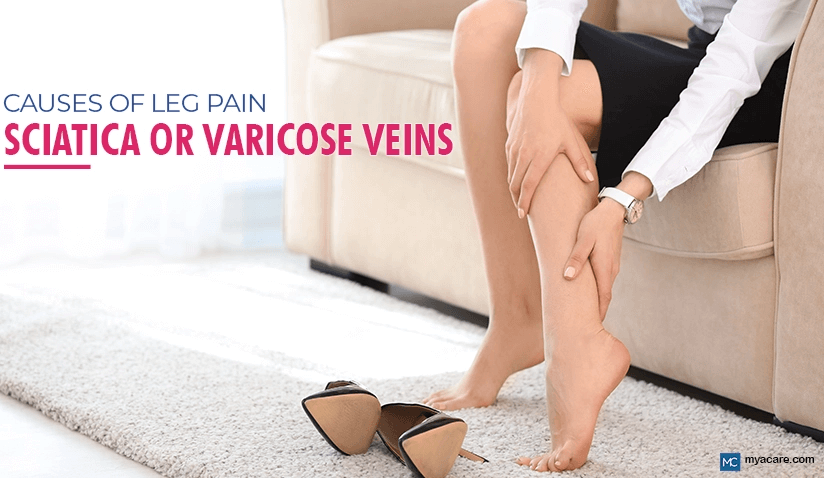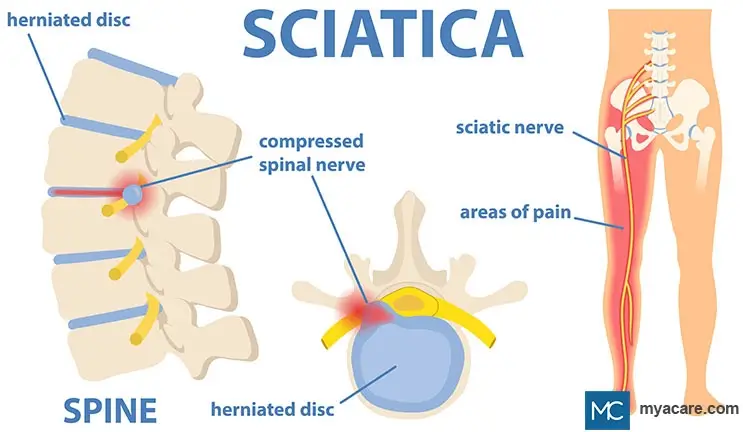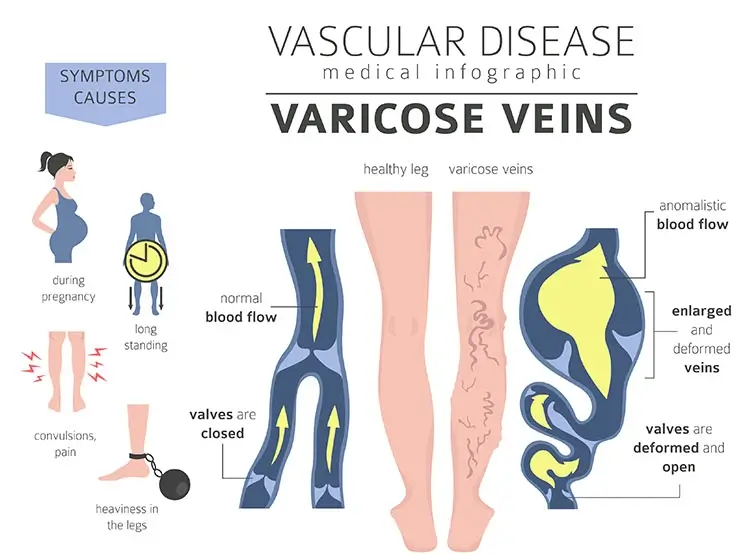Is My Leg Pain Caused by Sciatica or Varicose Veins?

Are you having leg or foot pain and cannot figure out if it is because of sciatica or varicose veins? Admittedly, it might be difficult to differentiate the pain because sciatica and varicose veins may feel similar. Both have one common symptom, i.e., pain in the legs and/or foot. However, the two conditions are different.
Sciatica usually appears on one side of the lower back, buttocks, legs, or feet, while varicose veins can develop on the feet, legs, ankles, or calf.
Varicose veins are near the skin surface and are easy to see. You can identify varicose veins by checking the symptoms, for example, painful, swollen, bulgy, and discolored veins in your legs, feet, ankles, or calf. However, you could go for an ultrasound to further confirm the diagnosis.
In this article, we will discuss the differences between sciatica and varicose veins and how to figure out the actual cause of your leg or foot pain.
What Are Sciatica And Varicose Veins?
Sciatica refers to the pain and irritation in your sciatic nerves. The sciatic nerve is the longest nerve in our body that originates from your lower back to the buttocks and extends down to the legs. Sciatica commonly occurs on one side of the body.
In sciatica, you will experience sharp, shooting pain typically on one side of the body that will extend from your lower back down to the legs. Sciatica is often caused by a herniated disc.

Varicose veins are a condition in which the veins in your legs or feet become twisted, dilated, enlarged, and overfilled with blood.
In varicose veins, you will see that your veins appear painful, swollen, and raised, having a purplish-blue or red color.
The difference between sciatica and varicose veins is that sciatica is a neurological disorder, while varicose veins are a vascular disease. But both these conditions may show the same type of pain in the legs or the feet.
The Symptoms Of Varicose Veins
The symptoms of varicose veins are:
- Appearance of swollen veins in the legs, ankles, or feet.
- The lumpy, bulging, and twisted appearance of the veins in the feet or legs.
- Pain in the feet or legs while standing and walking.
- Red or purplish-blue skin color.
- Itching of the skin.
- Heavy feeling in the legs or feet.
- Muscle cramping, burning sensation, swelling, and throbbing in the feet or the lower.
- Discomfort in the legs or feet.

Where Do Varicose Veins Appear?
Varicose veins can develop anywhere on the lower half of the body, like the calves, feet, or ankles. It can also happen in the pelvic area or the testicles.
The Symptoms Of Sciatica
The symptoms of sciatica include:
- Moderate to severe pain in the buttocks, lower back, or legs.
- Sharp pain that worsens suddenly with movement.
- Numbness or weakness in the buttocks, lower back, legs, or feet.
- Hip pain.
- Tingling or burning sensation down the legs.
- Pins and needle-like sensations.
- Pain that feels like an electric shock or jolt.
Difference Between Sciatica And Varicose Veins Symptoms
- Sciatica does not cause swelling, redness, or warmth, while varicose veins can lead to swollen, twisted, enlarged, and lumpy veins with skin discoloration.
- Sciatica is associated with shooting pain that runs from the lower back to the legs, while varicose veins can cause leg heaviness, pain, and uncomfortable feet or legs.
- Varicose veins do not cause shooting pain extending and radiating to the lower extremities downwards from the buttocks. Pain from varicose veins arises from a specific part of your legs or feet, usually at the place where the veins are swollen, bulgy, and twisted. On the other hand, sciatica pain radiates downwards like an electric shock.
Can Varicose Veins Feel Like Sciatica?
Yes. Although both conditions are different, pain from varicose veins can feel like sciatica as both usually occur on the lower legs or feet. You can check for symptoms like swelling, lumpy, twisted, and blue or purple-colored veins on your foot or legs to identify if the pain is because of varicose veins. Moreover, if the cause of your pain is sciatica, you won't see any vein discoloration.
How To Confirm The Diagnosis Of Sciatica And Varicose Veins?
The symptoms of sciatica and varicose veins can vary from patient to patient. Hence, everyone may not experience the same symptoms mentioned above. So, apart from the physical diagnosis of the symptoms, it is good to get tests done to confirm the condition.
Diagnostic Test To Confirm Varicose Veins
To diagnose varicose veins, a leg test named venous doppler ultrasound of the leg is commonly recommended by the doctor.
Venous Doppler Ultrasound Of The Leg:
This test reveals the internal image and structure of the veins to confirm varicose veins. A handheld device called a transducer is made in contact with the legs or the area that needs to be examined. The transducer transmits the image of the veins to the monitor, and the doctor observes the internal appearance of the veins of the legs or feet to diagnose varicose veins.
Diagnostic Tests To Confirm Sciatica
To diagnose sciatica, the doctor may recommend any of the following tests:
- CT scans or MRIs to observe a detailed image of the back tissues, nerves, and bones.
- Nerve conduction velocity test, for example, electromyography, to identify how well electrical impulses pass through the sciatic nerve and observe the muscle response.
Conclusion
The pain of varicose veins and sciatica can occur on the legs and feet, but varicose veins are comparatively easier to diagnose.
You might have varicose veins if the physical appearance of the veins in your legs, feet, ankles, or calf look bulgy, twisted, swollen, and blue or purple-colored. Varicose veins also make your legs or feet feel heavy, aching, and uncomfortable.
With that, sciatica pain is mostly a sharp radiating pain that starts from your buttocks or lower back and extends down the legs.
If you are still unsure about your pain, CT scans, ultrasounds, and MRIs are available to confirm the diagnosis with the help of internal imaging of the veins.
To search for the best Cardiology healthcare providers in Croatia, Germany, India, Malaysia, Poland, Singapore, Spain, Thailand, Turkey, the UAE, the UK and The USA, please use the Mya Care Search engine
To search for the best Orthopedics Healthcare Providers in Croatia, Germany, India, Malaysia, Singapore, Spain, Thailand, Turkey, Ukraine, the UAE, UK and the USA, please use the Mya Care search engine.
To search for the best healthcare providers worldwide, please use the Mya Care search engine.
Dr. Fatima Munir is a Doctor by profession, a freelance content writer, and a researcher. With a penchant for research, she diligently curates facts and the latest literature to guide readers on all matters of health.
References:
Featured Blogs



